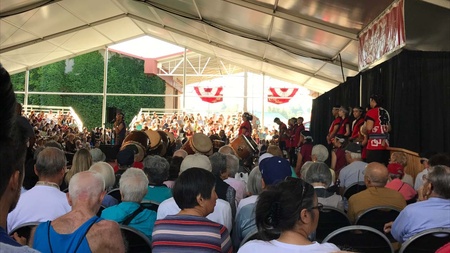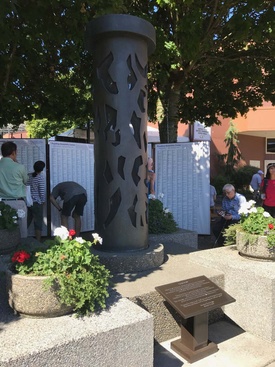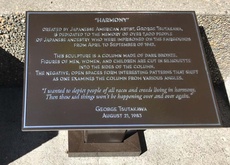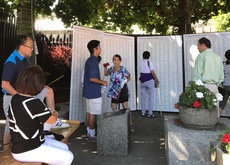September 4, 2017 was the first day of the Washington State Fair. For the Seattle-area Japanese American community and allies (and beyond) it was a commemoration, a reunion, a pilgrimage. And with close to 1500 attendees, it was the biggest Day of Remembrance I’ve ever seen.
I’ve parked my car and I’m walking next to the Washington State Fairgrounds—though I’ve lived in Washington for almost twenty years, this is my first visit to the Fair. Along the path to the main entrance, there is a stream of volunteers, greeting people there for the Puyallup Day of Remembrance. Almost immediately, I see a friend, Jan Yoshiwara, from Olympia. We had touched base briefly over e-mail a few weeks before, but I was happy to see her again. We met three years ago, at the Tule Lake Pilgrimage; fellow pilgrims become pilgrimage “family.” Jan walked me towards the fair entrance, and left me there.
Just as I entered the fair, I stopped for a minute. I thought about the friends I had met over the last few years, those who were incarcerated at the Puyallup Fairgrounds when it was “Camp Harmony.” I thought about my friend Cho Shimizu, who I’d interviewed about his memoir a few years back; about Elsie Taniguchi, who is at nearly every area Nikkei event, and was incarcerated at the fairgrounds as a child. And I thought about Fife artist Mizu Sugimura, whose extended and immediate family was incarcerated at several sites, including Puyallup and Tule Lake. Mizu wrote later: “Since my father quietly turned and told my brother and I that he once lived here while we were touring the fair exhibits …, I have never been able to shake the sadness and emotional angst that he conveyed and that this story inspired, even as I enjoyed other aspects of the annual family event.”
On my way to the event stage, there is another line of volunteers, older and younger, greeting more people. I see the daughter and granddaughter of one of my graduate school mentors. A friend who spoke at the Tacoma Day of Remembrance, member of the Whitney Memorial Methodist congregation which began in Tacoma and moved to Puyallup. A neighbor and friend. The greetings continue for hours. My daughter’s third grade teacher. A former student from my academic life. Volunteers from Densho, where I’ve done some grant writing. More volunteers passing out event programs and water bottles and even packages of arare. One of the event organizers, Eileen Yamada Lamphere, who was still wide-eyed at the number of people who were still coming in for the event. So many people that I’ve met over the last few years in my role as a Northwest correspondent for Discover Nikkei. “While we had always hoped for a good turnout,” Eileen told me later, “the numbers were beyond my expectations. What struck me most was the number of survivors, not just of PAC, who came out and allowed us to honor their survival and experience. For many this was the first time they had returned the fairgrounds, even though they live locally.”
Looking at the lines of Japanese Americans, all headed towards the same place, I think about how rarely in my life I have seen this happen. I think about the very first Day of Remembrance that Sansei activists staged, in another line of cars and buses, down to this same spot. And of course, I think about the lines of Japanese Americans during the war, all lined up for a very different reason.
When I arrive at the event stage, about half an hour before the event, the bleachers are already full. I am standing next to one set of the bleachers. Elsie Taniguchi, past president of the Puyallup Valley JACL, welcomed the crowd and urged us gently to make room for those who needed seats. She brought out local journalist Lori Matsukawa, who served admirably as mistress of ceremonies. After a stirring performance by Seattle Matsuri Taiko/Kokon Taiko/Kaze Daiko, I was happy to see pilgrimage friend Stan Shikuma and one of my former students, Steve Soule among the performers. And I was pleasantly surprised to see the Washington State Board CEO Kent Hojem on the program; he welcomed the event attendees, acknowledging the intertwined nature of the history of the Fairgrounds and the Japanese American community. Densho director Tom Ikeda reminded each of us that we can reach out to those who are being affected by destructive policies and laws and crimes.

Directly in front of me, there were rows and rows of seats of survivors and their partners or caretakers. At one point, when asked, they all took out a small bamboo stalk—symbolizing long life and resilience—and waved it in the air. They also stood for the national anthem and pledge of allegiance. I thought about those pictures of Japanese American schoolgirls, pledging allegiance to the flag. I thought about one of my aunties, who always sang the “Star-Spangled Banner” in her clear and strong alto voice before basketball games at UC Berkeley; she was a young child when she was in camp, only about three years old. And of course, I thought about all of the national conversations about standing for these symbols and acts, about the different and difficult ways our community has been asked to prove our loyalty to our country. It was a complex moment for me.
A thoughtful and moving portion of the program was the Planning Committee’s recognition of "profound acts of kindness" by the allies who helped Seattle area Japanese Americans during and after the war. This portion of the program was always part of the Camp Harmony Committee work, but the term ‘Profound Acts of Kindness’ was coined by event coordinator Sharon Sobie Seymour. With the assistance of local Nisei author Cho Shimizu, Seymour and other committee members created a list of individuals and acts, and found their descendants. The acts of kindness covered a range of acts—and there are many more stories, says Seymour. Father Leopold Tibesar and Pastor Emery Andrews from Seattle provided spiritual support and supplies for their incarcerated parishioners. People like the Serosky, Orton and Andre families, who stored belongings, paid property taxes, and provided farming supplies for their Japanese American neighbors during and after the war. Descendants of these families were present at the event, and they received a standing ovation from the audience. In a message after the event, Seymour explained more of the rationale behind honoring these individuals: “I also strongly feel the way to encourage more Acts of Kindness is to highlight and share the stories…Let society and especially our young know that it's not enough to ‘not be bad or evil,’ one needs to take action to help.”
After the program was over at the stage, people joined a procession across the fairground to George Tsutakawa’s sculpture “Harmony.” The committee had raised money for new signage for the sculpture, which was unveiled by Tsutakawa’s daughter Mayumi. In addition, the Camp Harmony Committee had created a banner containing as many names of Camp Harmony “residents” as possible. This part of the morning was so well-attended, I had to stand on top of the water sculptures to get anything like a picture. But to watch the lines of Japanese Americans again, young and old, to walk up to the banner—to touch their family names, or their own, to get a picture of their names on the banner. I had that same feeling touching my family’s names on the Tule Lake registry at the Butte Fairgrounds museum. This, too, was something like making history. Or at least, making history our own again.
In this year of remembrance, there have been so many events, so many moments, but I am still holding on to this one. It was the collective moment of silence, recognizing the Issei and Nisei who have already left us. "You will not be forgotten," said MC Lori Matsukawa, and the silence in that tent was palpable.
Thanks are due to the planning committee members, many of whom volunteered their time and efforts for several years: Barbara Mizoguchi-Asahara, Elsie Yotsuuye Taniguchi, Eileen Yamada Lamphere, Cho Shimizu, Sharon Sobie Seymour, Lori Tsugawa Whaley, Molly Wilmoth, and Stephen Kitajo.
© 2017 Tamiko Nimura









